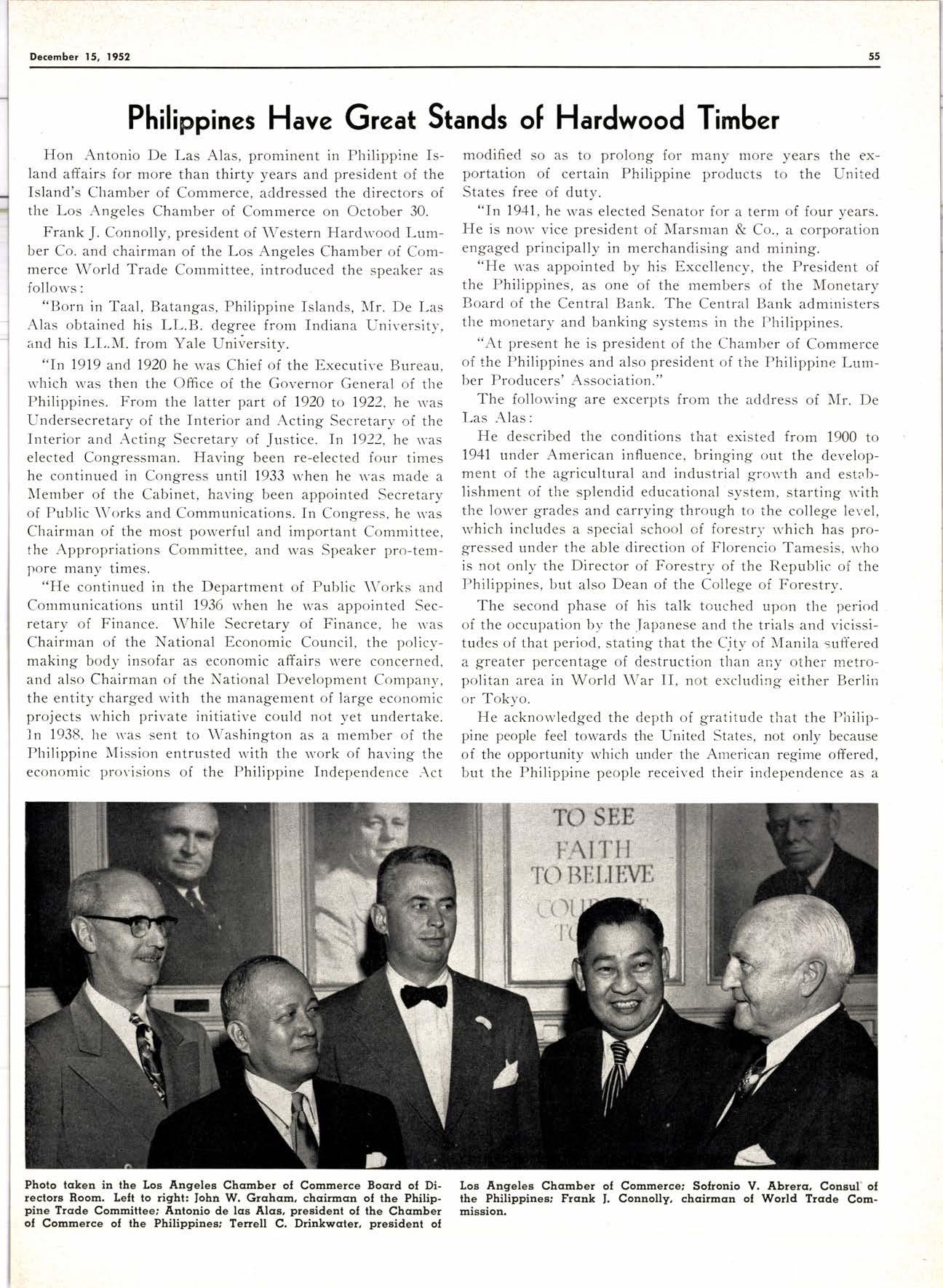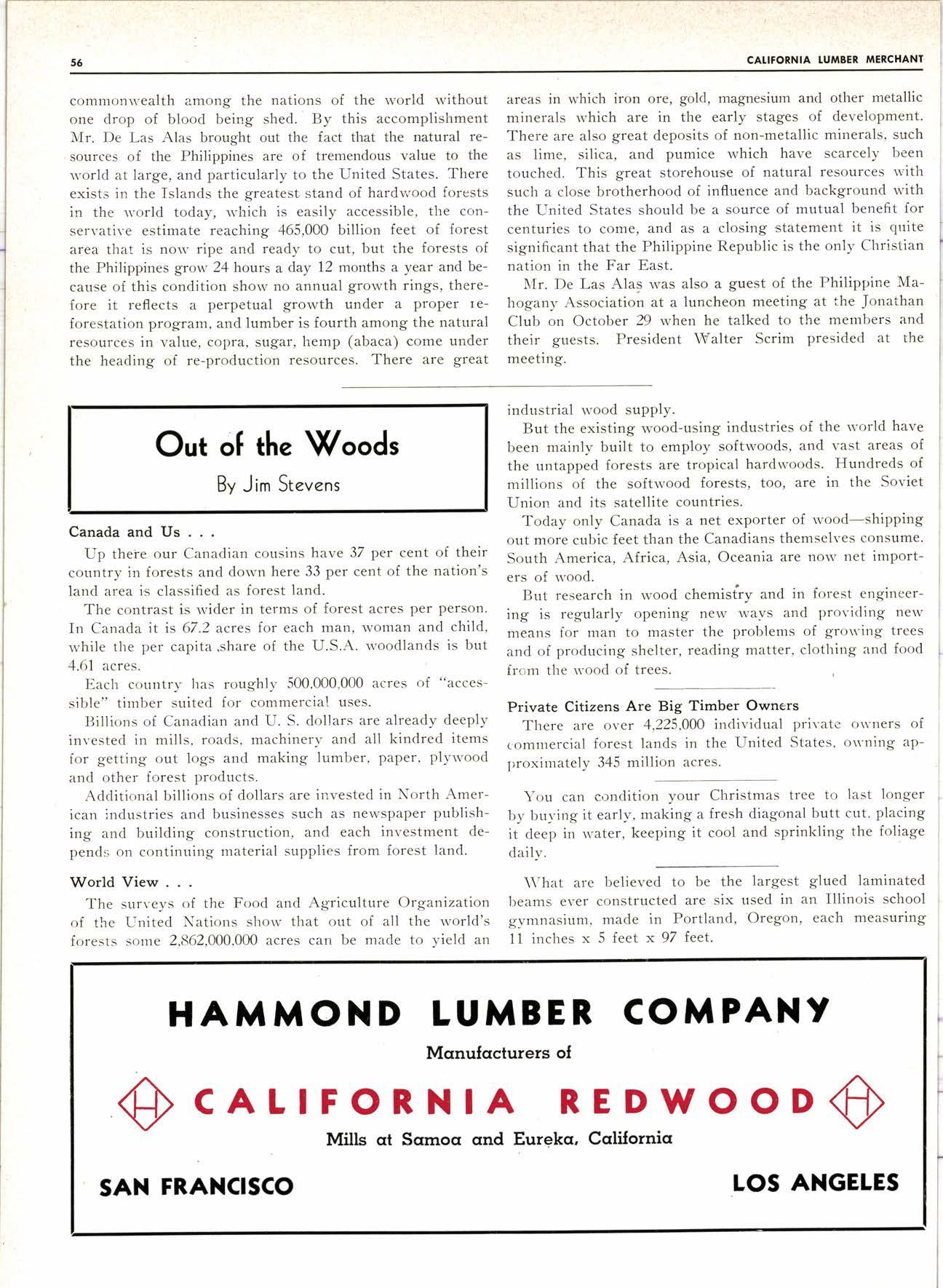
3 minute read
Philippines Have Great Stands o[ Hardwood Timber
Hon Antonio De Las Alas, prominent in Philippine Island affairs for more than thirty years and president of the Island's Chamber of Commerce, addressed the directors of the Los Angeles Chamber of Commerce on October 30.
Frank J. Connolly, president of \\restern Hardn'ood Lumber Co. and chairman of the Los Angeles Chamber of Commerce World Trade Committee, introduced the speakel as follo'rvs :
"Born in Taal, Batangas, Philippine Islands, Mr. De Las Alas obtained his LL.B. degree from Indiana University, ind his I-L.M. from Yale Universitv.
"In l9l9 and l92O he rn'as Chief of the Executive Bureau, rvhich n'as then the Office of the Governor General of the Philippines. From the latter part of 1920 to 1922, he u'as Undersecretary of the Interior and Acting Secretary of the Interior and Acting Secretary of Justice. In 1922, he u'as elected Congressman. Having been re-elected four times he continued in Congress until 1933 when he u.as made a N{ember of the Cabinet, having been appointed Secretary of Public \\rorks and Communications. In Congress, he u'as Chairman of the most powerful and important Committee, the Appropriations Committee, and was Speaker pro-tempore many times.
"He continued in the Department of Public \Vorks and Con"rmunications until 193 rvhen he was appointed Secretary of Finance. While Secretary of Finance, he l as Chairrnan of the National Economic Council, the policvmaking body insofar as economic affairs rvere concerned, and also Chairman of the National Development Companv, the entity charged r,vith the management of large economic projects rvhich private initiative could not vet undertake. ln 1938. he u'as sent to Washington as a member of the Philippine Mission entrusted u'ith tl-re u'ork of having the economic provisions of the Philippine Independence ,\ct modified so as to prolong for many more years tl,e exportation of certain Philippine products to the United States free of duty.
"In 7941, he.il'as elected Senator for a term of four years. FIe is norv vice president of Nlarsman & Co., a corporation engaged principally in merchandising and mining.
"lIe 'ivas appointed by his Excellency, the President of the Philippines, as one of the members of the Monetary Board of the Central Bank. The Central Bank administer's the monetary and banking systems in the Philippines.
"At present he is president of the Chamber of Commerce of the Philippines and also president of the I'hilippine Lumber Prodncers' Association."
The follo'iving are excerpts from the address of Mr. De Las Alas:
He described the conditions that existed from 1900 to 1941 under American influence, bringing out the development of the agricultural and industrial gror."'th and establishment of the splendid educational svstem, starting rvith the lorver grades and carrying through to the college le.,'el, lvhich includes a special school of forestry rvhich has progressed under the able direction of Florencio Tarnesis, rvho is not only the Director of Forestry of the Republic of the Philippines, but also Dean of the College of Forestrv.
The second phase of his talk touched upon the period of the occupation by the .fapanese and the trials and vicissitudes of that period, stating that the Cjty of N{anila suffered a greater percentage of destruction than any other metropolitan area in World \\rar II, not exclucling either Berlin or Tokyo.
He acknor,vledged the depth of gratitude that the Philippine people feel towards the Unitecl States, not only because of the opportunity which under the An-rerican regime offered, but the Philippine people received their independence as a common\\realth among the nations of the rvorld without one drop of blood being shed. By this accomplishment Mr. De Las Alas brought out the fact that the natural resources of the Philippines are of tremendous value to the rvorld at large, and particularly to the United States. There exists in the Islands the greatest stand of hardwood forests in the rvorld today, rvhich is easily accessible, the conservative estimate reaching 465,000 billion feet of forest area that is nolv ripe and ready to cut, but the forests of the Philippines grow 24 hours a day 12 months a year and becatrse of this condition shorv no annual growth rings, therefore it reflects a perpetual growth under a proper reforestation program, and lumber is fourth among the natnral resources in value, copra, sugar, herap (abaca) come under the heading of re-production resources. There are great











